Picking an ecommerce platform: WooCommerce or Shopify?

Nowadays, building an online store is easier than ever. Picking the right tool to power your new store isn’t. There are many tools out there, but for most people, the choice will be between the two market leaders: Shopify and WooCommerce. Although both ecommerce platforms have a comparable feature set, they have a different philosophy. Let’s take a look at both.
Table of contents
TLDR: There’s no perfect solution
Let’s start with the conclusion. The answer to the question of which ecommerce platform you should pick is those two words that every SEO expert likes to utter regularly: it depends! It’s almost a philosophical battle between two different worlds: open and flexible, and closed and “rigid”. In general, you can achieve the same things on both platforms. Both WooCommerce and Shopify are great platforms that help site owners build awesome online stores. The main difference is how they do it and the philosophy behind it.
WooCommerce gives you great flexibility and total ownership over your shop and data. This is a great option if you want to control everything — and if you embrace the open-source mentality. Plus, if you already have a WordPress site then it makes much more sense to add a WooCommerce store to it than to start a new store on Shopify. And, if you want a hosted version of WooCommerce, there are plenty of great hosting providers that can provide you that option.
With Shopify, you get a closed system — also known as a SaaS, or Software as a Service. Everything is arranged for you and everything is set up in such a way that you can literally build and launch an online store in minutes. A closed framework like Shopify has many benefits as you get a system that is perfectly tuned to its task: getting you to sell as much as possible. It does mean that Shopify owns your data and that you lose flexibility. Everything you can do is inside the platform and its apps.
Simply put, it’s not that one is better than the other. You simply need to pick the platform that fits your goals and preferences.
What is Shopify?
Launched in 2006, Shopify is an ecommerce platform that powers around 1.7 million online stores worldwide. Shopify is a hosted web application, which means that it’s Software as a Service (SaaS), carefully fine-tuned to make it very easy to build and run online stores. It offers a ton of tools that shop owners can use to start and run their online store.
Over the years, Shopify built many in-house solutions to common ecommerce problems, like payment systems (Shopify Payments) and fulfillment networks. Today, Shopify is a full-service ecommerce platform that makes a lot of sense and gives enough options for a lot of people.

What is WooCommerce?
Launched in 2011, WooCommerce firmly has its roots in the open-source WordPress community. WooCommerce is a complete ecommerce plugin that you can simply bolt onto your WordPress site. It’s full-featured and robust, with tried and tested performance. Since 2015, WooCommerce is part of the Automattic family.
WooCommerce is a very popular and cost-efficient way of running an online store. On this basis, WooCommerce doesn’t cost anything and even many of the extensions are free to use. There’s a whole economy built around WooCommerce, with thousands of services, themes, and plugins at various price points. People value the freedom they feel while building a store with WooCommerce.
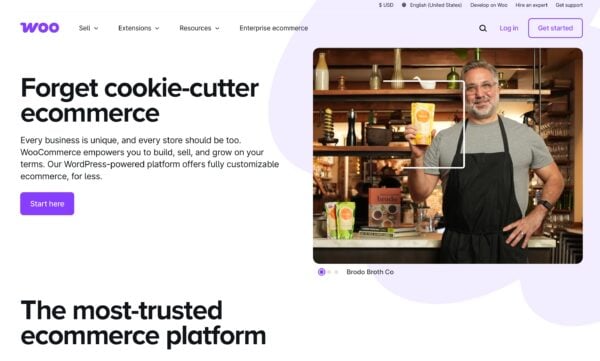
A managed platform vs. a self-hosted one
The biggest difference between Shopify and WooCommerce is the way they host your site. With WooCommerce, you can download the free WordPress plugin and install it on any given server. Simply pick a good hosting plan and you are good to go. You have full control over the way WooCommerce works and you can scale your tech stack if your site is doing great.
This does also have its drawbacks, of course. For instance, you are fully responsible for every part of your store. You need to keep everything safe and secure and you are the one making the performance optimizations needed to perform well. Of course, there are services to help you do this, but it still requires some extra effort. So, while WooCommerce is free to use, it’s not without cost. This is something to take note of. And, if you really want a hosted solution with WooCommerce, you can always sign up for the ecommerce plans on different WordPress hosting providers.
When you choose Shopify, you sign up with them and pay them a monthly fee to host and run your store. Everything you do is inside their “walls”, so to say. Shopify comes with restraints purposely built in to make sure that their stores all function properly. Shopify takes care of everything, from payment to backup and security.
If you do want to expand a bit, Shopify comes with an app store that features many helpful tools, like SEO apps, email marketing, inventory management, and much more. These range from free to a monthly added cost that’ll quickly increase the price you pay for your store. Another thing to remember is that Shopify charges a 2% transaction fee on the cheapest plan, when not using Shopify Payment. More on that later.
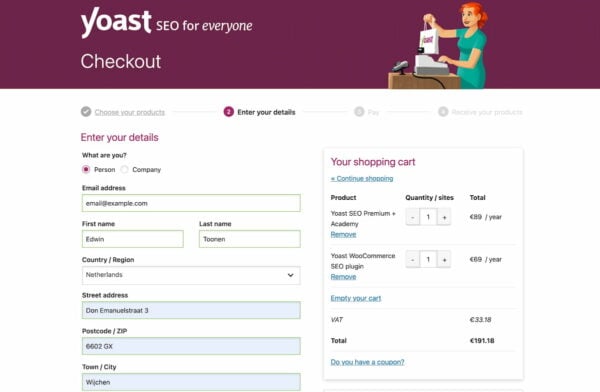
Comparing Shopify vs. WooCommerce
Shopify and WooCommerce haven’t become the two leading e-commerce platforms in the world by chance. Both platforms are very robust, easy-to-use, secure, and offer loads of features. The features are comparable, and so is the way they think about ecommerce. The biggest difference is in the flexibility of open-source versus the solidness of closeness. Let’s take a closer look at the differences between the two.
Pricing
Shopify is paid software and doesn’t come with a free plan. There are three plans to choose from, starting from $29 a month up to $299 a month. The different plans come with different options, for instance, the basic plan doesn’t come with reports and internationalization features. For the enterprise-level businesses, there’s also Shopify Plus. Another plan is Shopify Lite that lets you add products to an existing blog for a small fee.
The kind of plan you get, also influences what you pay Shopify for handling transactions. For instance, the transaction fee if you are not using Shopify’s own payment system is 2% for the Basic plan, 1% for the middle plan, and 0.5% for the Advanced plan. There are also different rates for online handling of credit cards, starting at 2.9% + 30¢ USD per transaction.
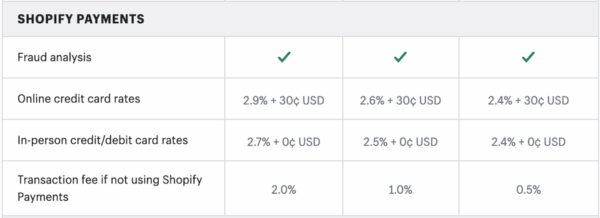
If you use WooCommerce Payments, you don’t pay a fee to handle credit cards but there is a regular charge of 2.9% + 30¢ USD per transaction. WooCommerce itself is free to install and use, but will come with a lot of added costs. For instance, you need to pay for hosting (pick a good WordPress host — that’s essential), a domain, themes, plugins, development costs, et cetera. It is possible to keep it low budget and do most of it yourself, but if you can’t you will need to invest.
Still, a WooCommerce store will probably turn out cheaper — especially if you are on more expensive Shopify plans and need some expensive app subscriptions to get your store to run properly.
Ease-of-use
While both products are pretty easy to use, Shopify is on another level. One of the biggest advantages of a hosted ecommerce platform is that after you sign up, you can immediately start to work on your site. Shopify is set up to guide you from A to Z in such a way that you can launch your site in minutes. You won’t see any code and you can just click around to get your store looking like you want.
With WooCommerce, it might take a little more to get going because you need to go through the process of installing it. What’s more, if you don’t have a WordPress site you need to set that up as well. Luckily, there are plenty of high-quality web hosts that offer all-in-one plans for WooCommerce shops. Once you’ve set up everything, you can run through the settings, install WooCommerce add-ons, pick a theme et cetera, et cetera.
As WooCommerce is proud of its flexibility, it comes with everything and the kitchen sink, giving you detailed control over the store. What WooCommerce doesn’t have out of the box, you can add via add-ons. All of this does mean that WooCommerce is less beginner-friendly than Shopify.
Appearance: themes
Having a great, functional look for your online store is important. If your site appears messy, potential customers will likely not trust it. Luckily, both ecommerce platforms come with ample choice to get the design you want for your products to stand out.
Shopify has around eighty themes available in the Theme Store, both free and premium. Not too long ago, Shopify announced Online Store 2.0, a completely redesigned theme architecture — including a cutting-edge new default theme. This makes it a lot easier to customize themes as you can now edit every section of your site, not just your homepage. Shopify will use a Gutenberg-like block system to help you build those pages. All of this will help you get more done, without touching any code.

WooCommerce benefits from having a massive market built around it. While there are about forty themes available in the official marketplace, resellers like ThemeForest and TemplateMonster offer thousands of WooCommerce themes in all shapes and sizes. Not to mention high-quality individual WooCommerce-proof WordPress themes like Astra. This being the WordPress space, you simply have a ton of options. But, of course, this can also be overwhelming if you are trying to find something quickly.
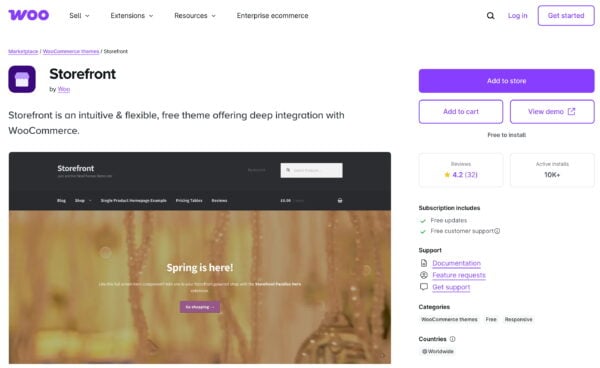
Flexibility
Is it possible to take control of your online store and change little details or are you stuck in a system someone else controls? It’s good to have options and, while both WooCommerce and Shopify have ample settings to explores and extensions to add, Shopify feels a bit more limited.
Of course, offering flexibility is great as it gives the user the power to tune the ecommerce site to their liking. On the other hand, it adds complexity and it takes time and effort to set it up and keep it running like a well-oiled machine. As mentioned, Shopify is a closed platform that is built to give you everything you need, but not too much. While WooCommerce is open, free to adapt and turn into something unique. The choice is yours.
Apps
The concept of apps or add-ons is well-established by now. In many solutions, you get a program that is set up to give you the minimal amount of tools you need to get your store going. If you want, you can work within these constraints and build a successful store. But, if you want more control, more insights, more features — you need apps to extend the platforms.
Shopify has a great set of apps you can use, from advanced analytics to email marketing. Some of those are free to use, but the best ones are paid services you sign up for with a monthly fee. These are not cheap and the price level is different from what we see in the WordPress space. Our WordPress plugin Yoast SEO Premium, for instance, costs just $99 a year, while, on average, a Shopify app costs around $20 to $30 a month. Sign up for a couple of apps and you are racking up the cost of your Shopify store. Also, keep in mind that it’s not wise to install more apps than you need as this can affect performance.
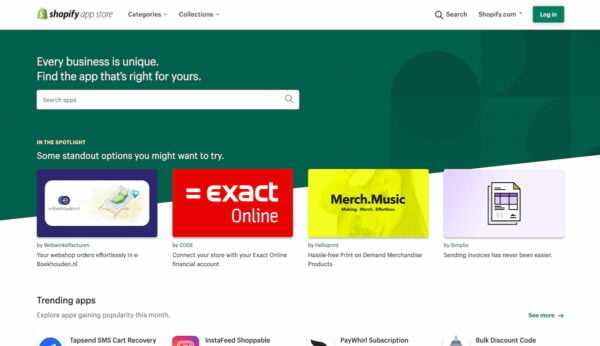
WooCommerce is WordPress, with all its pros and cons. WooCommerce comes with a lot of ecommerce tools built-in, but you can add specific features via add-ons. There are a ton of extensions for WooCommerce, in all shapes and sizes — built by WooCommerce, as well as any third parties. In general, these add-ons are less costly than their Shopify counterparts. Pricing is just different in the WordPress space.
Whatever you choose, both platforms let you extend your online store with specific and sometimes niche apps or add-ons that help you make the most of it.
Payment providers
Accepting payments is at the heart of every online store — without it, there is no store. It’s also the part where the costs and availability of (local) payment providers will play a big role. Rest assured, both WooCommerce and Shopify shine on this front. But, one is not like the other.
Shopify is adamant of you using Shopify Payments. You’re not required to use it, but it does have a cost-benefit. Shopify offers tons of payment options and almost every provider in the world is taken care of. But, Shopify would rather have you use Payments as that is within their walls. If you choose a different provider, you’ll notice that Shopify will add transaction fees that might rack up for you. Unfortunately, Shopify only offers Payments in a couple of territories, so in many cases, you have to use a payment provider specific to your locale. This will cost you extra.
Last year, WooCommerce introduced its own version of Shopify Payments called WooPayments. It doesn’t support everything for every locale, but you can extend this with add-ons for almost every payment provider in the world. WooCommerce doesn’t charge extra for using a different payment provider. Except for the costs that the provider itself charges. WooPayments doesn’t require a monthly fee, but it does incur costs per transaction.

Marketing
Setting up your store is only part of the journey, of course. Marketing will play a big role in how and if you can reach an audience that will buy in your store. Having marketing at your disposal right from the backend makes a lot of sense.
Shopify comes with a number of cool marketing tools, like a Facebook channel, the option to sell on Amazon, email marketing, gift card options, sales and discounts, and much more. Marketing is also where the Shopify apps shine as there are many dedicated tools that are aimed at getting more customers — or to get current customers to spend more. Shopify also comes with an abandoned cart recovery feature in every plan.
WooCommerce comes with fewer marketing features out of the box, but it has a whole app store full of marketing extensions. WooCommerce doesn’t come with its own email marketing feature but does integrate with things like MailPoet and Mailchimp. That means that you will be able to set up your marketing the way you want to, it will just take you a bit more effort to find the right extensions.
Content marketing
Marketing your shop isn’t just about writing an engaging product description. It’s also good to find a way to tell your story and produce content that will do well in the search engines. This makes it easier for potential customers to find you, even if they are not looking for your products yet. One of the tools you can use for this is having your very own blog.
Shopify has a blog feature and it’s pretty easy to get started with. Unfortunately, it’s also very basic and bare-bones. It’s good that it’s there and that it gives you the option, but you shouldn’t expect this to have to power of WordPress.
Of course, WooCommerce is built on top of WordPress so it uses the block editor. Adding a blog to your site with WooCommerce is easy and it gives you a very powerful tool to tell your story. You’ll also get to use all those cool tools, like the Yoast SEO plugin to make sure that the content is well-written and ready for the search engines. What’s more, the block editor will let you build even more cool stuff, like landing pages and the like. WooCommerce even comes with its own blocks for the block editor.
SEO
SEO is essential in bringing in customers. Of course, SEO is more than just setting up permalinks and working on your site structure. It also contains user experience, content writing, performance optimization, and much more.
Shopify comes with a default setup that is pretty SEO-friendly. You can work on your meta descriptions, canonicals are generated automatically, redirects work properly and you can even edit your robots.txt file, if necessary. If you want to do more, there are several SEO plugins in the Appstore that can help you. Or, you can use the brand new Yoast SEO for Shopify app. Of course, not everything is perfect and there are certainly improvements to make to the default setup. For instance, duplicate content can turn out to be a nasty issue in Shopify. You can read more about optimizing Shopify for search in our post Shopify SEO: the ultimate guide.
WooCommerce has a major advantage: because it is built on top of WordPress you can do a lot to improve your WordPress SEO. WooCommerce is pretty good at SEO and you get a lot more control over it — especially if you install a plugin like the Yoast WooCommerce SEO add-on. This plugin helps you set up the metadata for your products properly, including the necessary structured data markup. It also optimizes the product XML sitemap for your site and helps you visualize your products in Google.
Performance
A fast site offers a good user experience and a good user experience helps turn visitors into customers. It’s important to focus on improving the performance of your online store as much as possible. Again, Shopify and WooCommerce do this in different ways.
As Shopify is a managed web app, performance optimization is in their hands. There are not that many things you can do to enhance it, except for making sure that everything is set up properly and that you limit the use of apps, have a well-built theme, and optimize your images. Luckily, performance is one of the focal points for the Shopify development team and they are rolling out enhancements all the time. Another cool thing is that Shopify comes with a Fastly/Cloudflare CDN by default. If you need more control over the performance, you can always upgrade to the enterprise-level Shopify Plus plan.
With WooCommerce, you can control the performance in great detail. That’s awesome, but it’s also a drawback as you are responsible for the performance. This means you have to choose where to host it and to make sure that even more is set up properly. You need to pick a fast theme, manage your plugins, optimize scripts, get a CDN, et cetera, et cetera. This is awesome because you get to choose which knobs to turn. Of course, it is a lot less beginner-friendly. Luckily, with great WordPress hosting, your WooCommerce store will probably perform pretty well without having to finetune too much stuff.
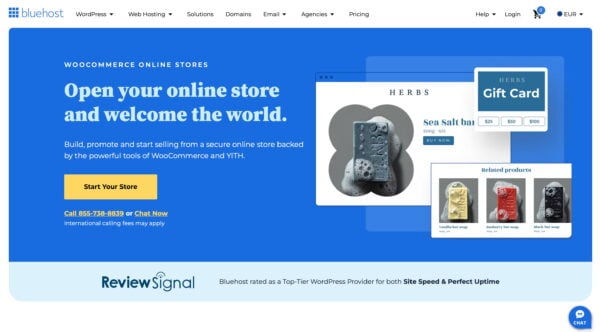
Security
Security is paramount for an online store. You don’t want your store to leak your customers’ credit card details, do you? It makes all the sense in the world to take extra care of security. Security is a major trust factor and if your customers can not trust your site, they won’t buy anything.
Because of their different approaches, Shopify and WooCommerce are not equal regarding security out of the box. Shopify is a web-based service so it controls everything it does. They take care of the hosting and security of your site. All the standard security things are available right away, like SSL certificates and 2-factor authentication. Shopify is also PCI-DSS compliant right out of the box, meaning you can accept credit cards right away.
With WooCommerce, things are different. WooCommerce as software is very secure, but you need to take care of it yourself. You install it on a server that you need to maintain, you’re responsible for getting an SSL certificate, keep your software updated et cetera. Of course, there are many tools and services that can help you secure your site in a professional way. None of this is really hard, but it is something to take note of.
Shopify vs WooCommerce conclusion
There are no answers to the question of whether Shopify or WooCommerce is better. Both are awesome tools to power your ecommerce store. Both have their merits and drawbacks, but the main difference is how it runs your online store.
With Shopify, you live and breathe on its platform, while WooCommerce lets you take control over everything. WooCommerce might be more cost-effective, but Shopify is a more lean-back solution. It’s not that one is better than the other, it’s just a choice you need to make depending on your skills, budget, and goals.
Read more: Check out our ecommerce SEO guide »


I really loved this article! People often wonder which is the best platform for blogging, and it is a great resource to help those people out.Thanks for this great post!
You’re welcome and thanks for your comment!
Shopify and WooCommerce both are the excellent. Both offer great tools and assistance to start and run a successful online e-commerce store.
Agreed, ManiMoon!